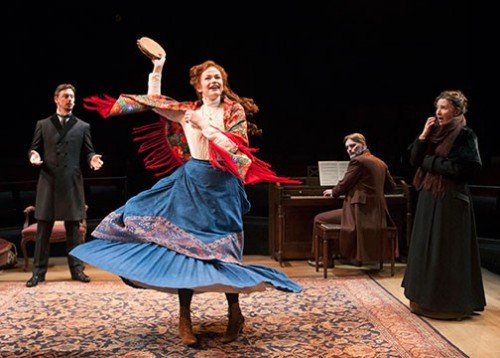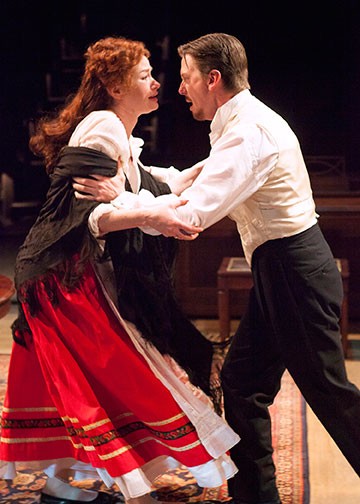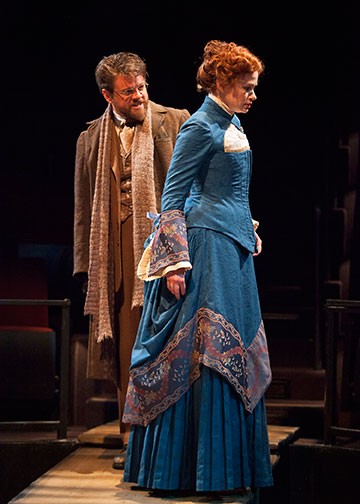A Doll's House at The Old Globe
Ibsen Drama in San Diego Through April 21
By: Jack Lyons - Apr 11, 2013
Henrik Ibsen, the great Norwegian playwright, is often referred to as “the father of realism” and one of the founders of modernism in the theatre. His plays were groundbreaking and controversial for his day. Europe and the Americas had prescribed societal rules that were not to be challenged. The arts, in general, very rarely reflected the hypocrisy of the day. But Ibsen, to his credit, continually bucked the conventions of the late Nineteenth century with such plays as “Peer Gynt”, “Ghosts”, “An Enemy of the People”, “Hedda Gabler”, and “The Master Builder”.
In his “master-work”, ‘A Doll’s House’, the hypocrisy of the day is clearly laid bare for all to see, except for those that did not want to see. The Old Globe production of “A Doll’s House” that opened at the Sheryl and Harvey White theatre on March 23rd is intelligently, sensitively, and seamlessly directed by Kirsten Brandt who brings a wealth of Ibsen directing credits to the production. It’s critical, if a production is to succeed and resonate with the audience, that the personal vision of the director has to be in evidence. Brandt’s direction from a new adaptation by Anne-Charlotte Hanes Harvey and herself nicely fits into the 250-seat White stage performing area.
Apparently, what didn’t fit in with a few female members of the Opening Night audience were plot points and dialogue that indicate that it’s okay to treat women in 1879 Norwegian society as pampered dolls. To be viewed as property of their husbands and not able to think for themselves, or make decisions on their own, is, I guess, what nettled them last week and Henrik Ibsen as well over a hundred years ago. Like the old Virginia Slims cigarette commercial of years ago used to coo, “you’ve come a long way baby” (with a little help from the Nineteenth Amendment to the US Constitution). I would imagine that that was exactly the reaction, however Brandt was expecting. Be that as it may, director Brandt and a first rate cast breathe life into Ibsen’s groundbreaking and controversial play. And females everywhere in the 21st century are still coping with male dominated societies and the laws written by the “old boy’s club”.
The story pivots on middle class housewife Nora Helmer (impressively played by Gretchen Hall), and her growing anxiety concerning a loan she secretly took out which now becomes the basis for blackmail by Nils Krogstad (Richard Baird) a shattered, disgraced and former director of the bank where Nora’s husband, a self-obsessed Torvald Helmer (Fred Arsenault) now is in charge. While honesty in a marriage is the best policy, it’s not always easy to negotiate why we make the decisions we make. Both Nora and Torvald, and Krogstad are trapped inside the boxes that 19th century culture has place them in, and from which, there is little chance of escape.
There are usually friends, however, with whom one can confide and look for support and answers. In Nora’s case she has Mrs. Kristine Linde played by talented Nisi Sturgis, whom I still remember from her “Peer Gynt” performance at the La Jolla Playhouse. Kristine, a former schoolmate, counsels Nora to tell Torvald the truth and her reasons behind her decision to take out the loan from Krogstad. The loan was to pay for Torvald’s recovery from a serious illness. Kristine believes honesty and the love between husband and wife and the home will, no doubt, carry the day.
Unfortunately, Torvald , is a prisoner of 19th century customs as well as in his community position as a stuffy bank manager, refuses to believe Nora, when she eventually informs him of Krogstad’s attempt to blackmail her. Krogstad’s demand for not going to Torvald with information that Nora forged a loan document is to have her pressure Torvald into giving him a position at the bank. He pleads with Nora saying “…look at me, I’m shipwrecked. Life is a rickety ship which is about to hit a storm.” Torvald refuses Nora’s intervention and suggestions, and hires Kristine to work at the bank instead. Torvald’s refusal to discuss their shattered relationship following the revelation leads Nora to make a life-altering decision. The premise of “A Doll’s House” and Nora’s decision may seem a little strange by today’s societal standards, but in 1879, there was little a disgraced housewife could do.
The first rate cast is solid in their portrayals. Gretchen Hall and Fred Arsenault who are real-life husband and wife, deliver extra spice to characters who are one hundred and eighty degrees opposite of themselves (according to program notes stating so). Richard Baird almost makes his desperate disgraced, banker a character we almost feel sorry for. I said “almost”. The supporting players: Jack Koenig as Dr. Rank, Katie Whalley as Helene, and Amanda Naughton as Anne-Marie, are spot on, as well.
The creative team for “A Doll’s House” led by director Brandt features a functional set designed by Sean Fanning, which allows for maximum space and movement. It’s the first time I’ve seen a production of “Doll’s House” performed in the round. Director Brandt does a nice job in making us forget we’re not in a proscenium theatre. The costumes of designer Alina Bokovikova nicely evoke the period, and the Lighting design by Davis Lee Cuthbert and the Sound design by Paul Peterson enhance the overall quality of finely judged and nuanced performances by the company of actors.
“A Doll’s House” runs through April 21st
Posted courtesy of Jack Lyons and Desert Local News.





